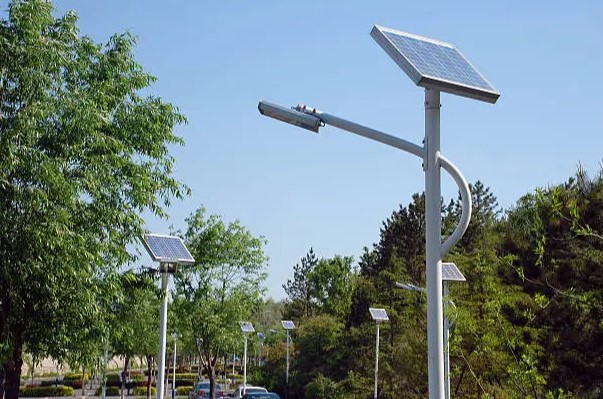When it comes to technological advancements in the light pole segment, the pioneering innovation is without a doubt solar street light technology. Starting off as simple standalone lamps, the current systems have transformed into smart and integrated eco-friendly infrastructure solutions. This shift is motivated by modern urban planning requirements. It has been made possible by companies like Inlux which provides Customized Solar Lighting Solutions For Municipalities, Governments, And Developers Worldwide.
For B2B customers such as urban planners, infrastructure project heads, and public works executives, it’s critical to keep pace with the advancement in solar street lighting for future city designs.
The Way Solar Street Lighting Has Changed Over The Past Decade
The past decade has curbed solar street lighting with innovations in smart infrastructure, renewable energy, and IoT. First designed to support off grid regions with basic illumination, the earlier models had bare functionalities — low lumen output, basic controls, and bulky battery systems.
However, current solar street lights are:
- High Efficiency: Monocrystalline solar panels with high conversion rate ensure supply of Advanced Solar Street Lamps.
- Intelligent: Motion sensor, Adaptive lighting, and Wireless Monitoring are smart features.
- Aesthetically flexible, It has sleek designs that match modern city skylines.
- Tough, built to endure extreme weather conditions and operate across various geographic areas.
Now, solar lighting has developed far enough that it is not a niche solution anymore; rather, it serves as an infrastructure option even for regions where power grids are in place, like urban ones. Smart lighting systems offer operational efficiency, ecological sustainability, and enhanced safety — all of these distinctly fit within smart city concepts.
New Smart Features Change the Purpose of Solar Street Lights
Solar street lighting systems harvest sunlight for powering LEDs, and the technology used is simple. Today, there are a multitude of smart technologies available that make systems more flexible, responsive to stimuli, and easy to manage remotely. These functions are crucial for scalable metropolitan infrastructure projects.
Prominent smart features of the system include:
- Adaptive lighting control: Provides motion-triggered brightness adjustments, based on the presence of people, ambient light, scheduled time, drastically reducing energy expenditures and light pollution.
- IoT integration: Direct supervision of energy consumption, battery state, and operative parameters through web and mobile applications.
- Predictive maintenance alerts: Systems can notify users in advance about the battery power, LED lifetime, or panel efficiency drops which increases operational readiness and reduces costs on maintained undertaking.
“Smart” Solar Power- Inlux Technologies
- Wireless Connectivity Features: Dashboards for smart cities are merged with data from Mesh networks and even 4G or 5G enabling data transmission in real time.
Data collection and functional smart urban infrastructure is enabled through advanced technologies such as the internet of things. With this technology, solar smart lights become a key component of smart cities providing holistic urban information and data along with illumination. Inlux as a global provider supports this-sustainable, customized and scalable illumination solutions lighting systems tailored to B2B projects.
Environmentally and Economically Impacting Solar Solutions B2B Projects
Cost-cutting and sustainability simultaneously are main drivers in adopting solar powered street lights among municipalities and B2B projects, as street lighting construction is easy and city development goals aligned with ESG (Environmental, Social, and Governance) goals more public-private partnerships work toward.
Sustainability Advantages:
- Emission Reduction: These power less technologies directly enable cities to be carbon neutral through solar powered systems eliminating CO₂ output.
- Recyclable Batteries: The latest system designs contain lithium or LiFePO₄ batteries which contribute to lower ecological impact after their life cycle.
- Less Light Pollution: Smart controls lessen light and energy wastage that causes concealment, which helps brighten skies.
Financial Advantages:
- Elimination of Metering: No need for a grid connection translates into removal of energy metering, trenching, cabling, and the entire overhead wiring buried hence drastically low installation cost.
- Reduced Operational Expenses: Total lifecycle costs are significantly lower than the traditional lighting due to the durable components and no monthly electricity bills.
- Easier Scaling: Accelerated or phased modular deployment designs are also based on urban growth and fund availability.
For both urban and rural developers and planners alike, investments like solar lighting provide numerous operational and reputation benefits. As an example, Inlux had large project undertakings where energy autonomy and cost predictability were vital to success.
Future Developments Which Will Influence Solar Lighting Systems the Most
Public infrastructure will further integrate advanced technologies with solar street lighting, enhancing its functionality and effectiveness. Important areas of focus are:
Use of AI and Machine Learning
Lighting schedules, maintenance predictions, and even the forecasting of new installation spots can be optimized by analyzing controlled data through Artificial Intelligence-powered systems.
Breakthroughs in Energy Storage
Incorporating solid-state and sodium-ion batteries into existing systems improves their efficiency, lifespan, and material usage from a sustainability perspective.
Integrated Smart Poles
The street solar lights of the future are expected to also serve as:
- Surf Public Wi-Fi hubs
- Surveillance Cameras
- EV Charging Stations
- Environmental Sensors
These multifunctional poles will enable the transformation of street lights into urban utility hubs, providing information to smart city systems while meeting diverse civic requirements from a single infrastructure.
Modular & Portable Solutions
Containerized solar lighting systems can be prefabricated for temporary or mobile installations (during festivals, emergencies, or construction), thus making these deployments faster and easier. As a result, B2B clients can purchase flexible assets with value in reusability.
City planners and developers are now able to equip their infrastructure for the future by acquiring developing technologies for the future, such as, Inlux, which is already aligning their product development according to these advancements.
Why the Future of Solar Street Lighting Is Bright for B2B Stakeholders
The shift towards purposeful sustainable development endeavors globally have advanced the positioning of solar lighting from merely a cost-saving endeavor to rather a strategic infrastructure solution. The government sets policies to mandate the use of solar powered solutions, climate financing is readily available for wide scale solar installation, and the public outcry for green powered infrastructure is continually on the rise.
B2B purchasers may gain from the following advantages:
- Competitive Bidding: Integrating solar solutions in bids for infrastructure projects can set a firm apart and fulfill ESG scoring standards.
- Reduced Project Risk: Solar lights ensure power availability and service continuity even in disaster-ravaged or off-grid regions.
- Compliance with International Standards: Many contemporary solar systems are designed to cross borders and are compliant with ISO, IEC, and regional standards for infrastructure projects.
To exemplify this trend, numerous urban revitalization and smart city initiatives now integrate solar-powered lighting as standard features rather than optional ones. And with strong technical partnerships, including Inlux, B2B stakeholders access sophisticated engineering, product tailored engineering, and comprehensive project management from procurement, through installation, and after-sales support.
In conclusion, solar street light systems are no longer an alternative; they stand as the future of urban illumination sustainability. The adoption of smarter, greener, and brighter solutions today provides cities and infrastructure planners with unparalleled long-term benefits, leadership in the environment, and operational effectiveness.
As Inlux continues pioneering design, sustainability, and connectedness, the prospects of infrastructure required for next-generation lighting are boundless.


